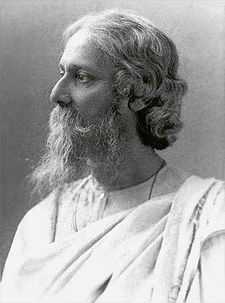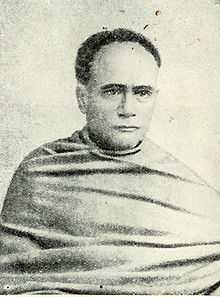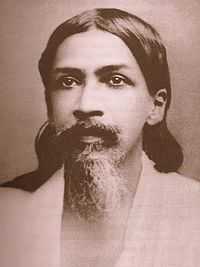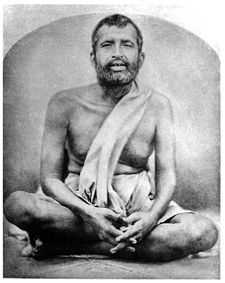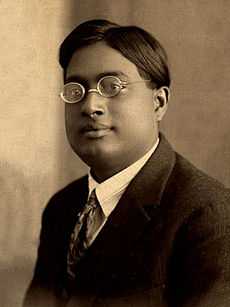Bengali renaissance
| |||||||
The Bengali Renaissance refers to a socio-cultural and religious reform movement during the nineteenth and early twentieth century in undivided India's Bengal province, though the impact of it spread in the whole of India. The Bengal Renaissance is said to have begun with Raja Ram Mohan Roy (1775–1833) and continued until the death of Rabindranath Tagore in 1941.The Renaissance was a revival of the positives of India's past and appreciation of the impact of the Modern West, as it had emerged since the Fifteenth-century European Renaissance. Thus, the Bengal Renaissance blended together the teachings of the Upanishad in order to create public opinion against Hindu superstitions including Sati, infanticide, polygamy, child marriage, caste-division, inter-caste hatred, Dowry, untouchability etc. and the efforts of the Christian Missionaries and the British Colonial Government who introduced Western varieties of education, politics and law to administer all those who indulged in superstitions and caste-based Hindu medievalism.
Social Reformation
During this period, Bengal witnessed an intellectual awakening questioning the prevalent orthodoxies concerning the social status of women, marriage, the caste system, superstitious beliefs and religion. One of the earliest social movements that emerged during this time was the Young Bengal movement, that espoused rationalism and atheism as the common denominators of civil conduct among upper caste educated Hindus.
The parallel socio-religious movement, Brahmo Samaj, developed by Raja Ram Mohan Roy during this time and counted many of the leaders of the Bengal Renaissance among its followers.[2] In the earlier years the Brahmo Samaj, like the rest of society, could not however, conceptualize, in that feudal-colonial era, a free India as it was influenced by the European Enlightenment (and its bearers in India, the British Raj) although it traced its intellectual roots to the Upanishads. Their version of Hinduism, or rather Universal Religion, although devoid of practices like sati and polygamy that had crept into the social aspects of Hindu life, was ultimately a rigid impersonal monotheistic faith, which actually was quite distinct from the pluralistic and multifaceted nature of the way the Hindu religion was practiced.
Leader Keshub Chunder Sen was devotee of Brahma, Krishna, Buddha and Christ. It has been argued by some scholars that the Brahmo Samaj movement, in spite of its universality, never gained the support of the masses and remained restricted to the elite, although Hindu society has accepted most of the social reform programmes of the Brahmo Samaj. It must also be acknowledged that many of the later Brahmos were also among the leaders of the freedom movement.
Dwarkanath Ganguly was a Brahmo reformer in Bengal of British India. He contributed substantially towards the enlightenment of society and the emancipation of women
Kadambini Ganguly was the first female graduate from India and the entire British Empire. She was also the first South Asian female physician, trained in western medicine, to graduate in South Asia. In 1883 she married the Brahmo reformer and leader of women's emancipation Dwarkanath Ganguly. They were actively involved in female emancipation and social movements to improve work conditions of female coal miners in eastern India. She was one of the six female delegates to the fifth session of the Indian National Congress in 1889, and even organised the Women's Conference in Calcutta in 1906 in the aftermath of the partition of Bengal. In 1908, she had also organised and presided over a Calcutta meeting for expressing sympathy with Satyagraha – inspired Indian labourers in Transvaal, South Africa. She formed an association to collect money with the help of fundraisers to assist the workers. As the mother of eight children she had to devote considerable time to her household affairs. She was deft in needlework.
Monomohun Ghose was the first practicing barrister of Indian origin.[1][2] He is notable for his contributions towards the fields of women’s education, for arousing the patriotic feeling of his countrymen and for being one of the earliest persons in the country in organised national politics.[3]
Ramgopal Ghosh was an Indian businessman, social reformer, orator and one of the leaders of the Young Bengal group. He was called the Indian Demosthenes.[1][2] Ghosh was one of the persons who helped John Elliot Drinkwater Bethune to establish his girls school. His speeches on the Black Acts (1850), which aimed at bringing disputes between Europeans and Asians under the jurisdiction of the Company's courts and those criticising the European protests against a well-intentioned government move to bring Europeans on par with the natives in judicial treatment were a landmark.[2] He was the first, as early as 1853, to demand the eligibility of Indians in the civil service examinations. In 1854, he was the first Indian to propose the establishment of universities in India. He supported the move of Dwarkanath Tagore to send four students to England for higher medical studies.[1]
Debendranath Tagore was a Hindu philosopher and religious reformer, active in the Brahmo Samaj ("Society of Brahmā," also translated as "Society of God"), which aimed to reform the Hindu religion and way of life. He was one of the founders in 1848 of the Brahmo religion, which today is synonymous with Brahmoism. Debendranath was a deeply religious man. His movement, the Brahmo Samaj, was formed in 1843 by merging his Tattwabodhini Sabha with the Brahmo Sabha, ten years after the death of Raja Ram Mohan Roy, founder of the Brahmo Sabha. The Brahmo Sabha had fallen away from its original aims and practices,[citation needed] as stated in its Trust deed of Brahmo Sabha. However, Tagore aimed to revive the importance of this deed.
Satyendranath Tagore was the first Indian to join the Indian Civil Service. He was an author, song composer, linguist and made significant contribution towards the emancipation of women in Indian society during the British Raj.
Spirituality
Ramakrishna was an Indian mystic during 19th-century.[2] His religious school of thought led to the formation of the Ramakrishna Mission by his chief disciple Swami Vivekananda.[3][4][5] He is also referred to as "Paramahamsa" by his devotees, as such he is popularly known as Ramakrishna Paramahamsa.
Swami Vivekananda was a Hindu monk and chief disciple of the 19th-century saint Ramakrishna. He was a key figure in the introduction of the Indian philosophies of Vedanta and Yoga to the Western world[2] and is credited with raising interfaith awareness, bringing Hinduism to the status of a major world religion during the late 19th century.[3] He was a major force in the revival of Hinduism in India, and contributed to the concept of nationalism in colonial India.[4] Vivekananda founded the Ramakrishna Math and the Ramakrishna Mission.[2] He is perhaps best known for his inspiring speech which began, "Sisters and brothers of America ...,"[5] in which he introduced Hinduism at the Parliament of the World's Religions in Chicago in 1893.
Sri Aurobindo was an Indian nationalist, philosopher, yogi, guru, and poet.[2] He joined the Indian movement for independence from British rule, for a while became one of its influential leaders and then became a spiritual reformer, introducing his visions on human progress and spiritual evolution. His main literary works are The Life Divine, which deals with theoretical aspects of Integral Yoga; Synthesis of Yoga, which deals with practical guidance to Integral Yoga; and Savitri: A Legend and a Symbol, an epic poem which refers to a passage in the Mahabharata, where its characters actualise Integral Yoga in their lives. His works also include philosophy, poetry, translations and commentaries on the Vedas, Upanishads and the Bhagavad Gita.
Paramahansa Yogananda was an Indian yogi and guru who introduced millions of westerners to the teachings of meditation and Kriya Yoga through his book, Autobiography of a Yogi.[1]. In 1920, Yogananda went to the United States aboard the ship City of Sparta, as India's delegate to an International Congress of Religious Liberals convening in Boston.[4][5] That same year he founded the Self-Realization Fellowship (SRF) to disseminate worldwide his teachings on India's ancient practices and philosophy of Yoga and its tradition of meditation.
Science
| |||||
The Bengal Renaissance saw the emergence of pioneering Bengali scientists such as Jagadish Chandra Bose, Satyendra Nath Bose, Upendranath Brahmachari, Meghnad Saha, Prafulla Chandra Ray, Prasanta Chandra Mahalanobis and Sisir Kumar Mitra.
Jagadish Chandra Bose was a polymath: a physicist, biologist, botanist, archaeologist, and writer of science fiction.[3] He pioneered the investigation of radio and microwave optics, made very significant contributions to plant science, and laid the foundations of experimental science in the Indian subcontinent.[4] He is considered one of the fathers of radio science,[5] and is also considered the father of Bengali science fiction. He was the first from the Indian subcontinent to get a US patent, in 1904. He also invented the crescograph. A crater on the moon has been named in his honour.[9]
Satyendra Nath Bose was a physicist, specializing in mathematical physics. He is best known for his work on quantum mechanics in the early 1920s, providing the foundation for Bose–Einstein statistics and the theory of the Bose–Einstein condensate. He is honoured as the namesake of the boson. Although more than one Nobel Prize was awarded for research related to the concepts of the boson, Bose–Einstein statistics and Bose–Einstein condensate—the latest being the 2001 Nobel Prize in Physics, which was given for advancing the theory of Bose–Einstein condensates—Bose himself was never awarded the Nobel Prize.
Upendranath Brahmachari was a noted Indian scientist and a leading medical practitioner of his time. He synthesized Urea Stibamine (carbostibamide) in 1922 and determined that it was an effective substitute for the other antimony-containing compounds in the treatment of Kala-azar (Visceral leishmaniasis) which is caused by a protozoon, Leishmania donovani. Brahmachari was a nominee for the Nobel Prize in 1929 in the category of physiology and medicine. He was president of the 23rd session of the Indian Science Congress in Indore (1936) as well as the president of the Indian Chemical Society, Calcutta (1936).
Meghnad Saha was an astrophysicist best known for his development of the Saha equation, used to describe chemical and physical conditions in stars. He was nominated for the Nobel Prize in Physics four times: 1930, 1937, 1939 and 1940.[6]
Prafulla Chandra Ray [1] was a chemist, educator and entrepreneur.[2]. The Royal Society of Chemistry honoured his life and work with the first ever Chemical Landmark Plaque outside Europe. He was the founder of Bengal Chemicals & Pharmaceuticals, India's first pharmaceutical company. He is the author of A History of Hindu Chemistry from the Earliest Times to the Middle of Sixteenth Century (1902). In 1896, he published a paper on preparation of a new stable chemical compound: mercurous nitrite.[3] This work made way for a large number of investigative papers on nitrites and hyponitrites of different metals, and on nitrites of ammonia and organic amines. He started a new Indian School of Chemistry in 1924.
Prasanta Chandra Mahalanobis FRS[1] a applied statistician. He is best remembered for introducing the Mahalanobis distance, a statistical measure in 1936. He made pioneering studies in anthropometry in India. He founded the Indian Statistical Institute, and contributed to the design of large-scale sample surveys.[1][3][4][5]
Sisir Kumar Mitra was a physicist.[2]. He gained a D.Sc. degree in 1919 at University of Calcutta; then he left for Paris, France to study at the University of Paris. There he earned a second D.Sc. and would join Marie Curie at her laboratory. Among his accomplishments were his investigations into the ionosphere. Dr. Mitra proposed that ultraviolet light from the sun created the middle, or E layer, of the ionosphere. He also determined that ions in the ionosphere's F layer were what caused luminescence of the night sky, giving it a dusty hue rather than pitch black. In 1947 he published a reference treatise titled "The Upper Atmosphere" on atmospheric research. A crater on the moon has been named in his honour.[9]
Literature
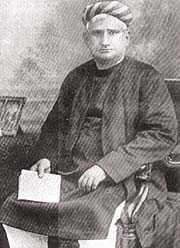
The renaissance period after the Indian Rebellion of 1857 saw a magnificent outburst of Bengali literature.
Rabindranath Tagore was a Bengali polymath who reshaped Bengali literature and music, as well as Indian art with Contextual Modernism in the late 19th and early 20th centuries. Author of Gitanjali and its "profoundly sensitive, fresh and beautiful verse",[3] he became the first non-European to win the Nobel Prize in Literature in 1913.[4] In translation his poetry was viewed as spiritual and mercurial; however, his "elegant prose and magical poetry" remain largely unknown outside Bengal.[5] Tagore introduced new prose and verse forms and the use of colloquial language into Bengali literature, thereby freeing it from traditional models based on classical Sanskrit. He was highly influential in introducing the best of Indian culture to the West and vice versa, and he is generally regarded as the outstanding creative artist of the modern Indian subcontinent, being highly commemorated in India and Bangladesh, as well as in Sri Lanka, Nepal and Pakistan.Tagore modernised Bengali art by spurning rigid classical forms and resisting linguistic strictures. His novels, stories, songs, dance-dramas, and essays spoke to topics political and personal. Gitanjali (Song Offerings), Gora (Fair-Faced) and Ghare-Baire (The Home and the World) are his best-known works, and his verse, short stories, and novels were acclaimed—or panned—for their lyricism, colloquialism, naturalism, and unnatural contemplation. His compositions were chosen by two nations as national anthems: India's Jana Gana Mana and Bangladesh's Amar Shonar Bangla. The original song of Sri Lanka’s National Anthem was also written and tuned by Tagore.
Ishwar Chandra Gupta Bengali poet and writer. He started the newspaper Sambad Prabhakar with Jogendra Mohan Tagore on January 28, 1831,[1] which finally became a daily on June 4, 1839. Many Bengali writers of the 19th century started their careers with that magazine. He reintroduced into Bengali poetry the mediaeval style with double meaning.He brought modern era of poetry in Bengali. He did not describe the life of Gods and Goddesses, but the daily life of human beings. He also wrote biographies of many Bengali poets and musicians.
Akshay Kumar Datta was one of the initiators of the Bengal Renaissance. Tattwabodhini Patrika was published as mouthpiece of both the Tattwabodhini Sabha and Brahmo Samaj. He was the first editor of the journal and contributed substantially towards the development of prose writing in Bengali. He was the first Bengali writer to seriously work for the propagation of a modern scientific outlook, writing books on Physics and Geography in Bengali. He also wrote profusely on astronomy, mathematics and geology. The students of Hindu College used to make fun of Bengali writing and some even felt that nothing worthwhile can be written in the Bengali language. However, whenever, Tattwabodhini Patrika came out they not only read it seriously but even brought it to the attention of one another.His magnum opus was the two-part Bharatbarshiya Upasak Sampraday (Vol.1, 1871, Vol.2, 1883). The brilliant introductions to the two volumes of this book evince his profound philosophical, linguistic and scientific learning and depth. Among others, Max Muller, Monier-Williams and Rajendralal Mitra were greatly impressed by his profound scholarship, though not agreeing on all points.
Romesh Chunder Dutt was an Indian civil servant, economic historian, writer, and translator of Ramayana and Mahabharata. Dutt served as the first president of Bangiya Sahitya Parishad in 1894, while Rabindranath Tagore and Navinchandra Sen were the vice-presidents of the society.[10] This was the society founded by L. Leotard and Kshetrapal Chakraborty in 1893 to cultivate Bengali literature. Dutt's The Literature of Bengal presented "a connected story of literary and intellectual progress in Bengal" over eight centuries, commencing with the early Sanskrit poetry of Jayadeva. It traced Chaitanya's religious reforms of the sixteenth century, Raghunatha Siromani's school of formal logic, and Ishwar Chandra Vidyasagar's brilliance, coming down to the intellectual progress of the nineteenth century.[11] This was presented by Thacker, Spink & Co. in Calcutta and Archibald Constable in London in 1895, but it had formed in Dutt's mind while he managed famine relief and economic recovery operations in Dakhin Shahbazpur and had appeared originally under the disguise of an assumed name in 1877.
Ishwar Chandra Vidyasagar, was a Bengali polymath and a key figure of the Bengal Renaissance.[1][2] he was a philosopher, academic educator, writer, translator, printer, publisher, entrepreneur, reformer, and philanthropist. His efforts to simplify and modernize Bengali prose were significant. He also rationalized and simplified the Bengali alphabet and type, which had remained unchanged since Charles Wilkins and Panchanan Karmakar had cut the first (wooden) Bengali type in 1780.[3]. He reconstructed the Bengali alphabet and reformed Bengali typography into an alphabet (actually abugida) of twelve vowels and forty consonants. He contributed significantly to Bengali and Sanskrit literature.Vidyasagar's "Barna Porichoy" is still considered a classic.
Michael Madhusudan Dutt was a popular 19th-century Bengali poet and dramatist.[1] . He was a pioneer of Bengali drama.[2] His famous work Meghnad Bodh Kavya (Bengali: মেঘনাদবধ কাব্য), is a tragic epic. It consists of nine cantos and is exceptional in Bengali literature both in terms of style and content. He also wrote poems about the sorrows and afflictions of love as spoken by women. Dutt is widely considered to be one of the greatest poets in Bengali literature and the father of the Bengali sonnet. He pioneered what came to be called amitrakshar chhanda (blank verse).
Sarat Chandra Chattopadhyay[1] was a Bengali novelist and short story writer of early 20th century. He primarily wrote novels, novellas, and stories. He converted three of his works into plays. His work represented rural Bengali society and he often wrote against social superstitions and oppression.
Bankim Chandra Chattopadhyay was a Bengali writer, poet and journalist.[3] He was the composer of India's national song Vande Mataram, originally a Bengali and Sanskrit stotra personifying India as a mother goddess and inspiring the activists during the Indian Independence Movement. Bankim Chandra wrote 13 novels and several 'serious, serio-comic, satirical, scientific and critical treaties' in Bengali. His works were widely translated into other regional languages of India as well as in English. He is widely regarded as a key figure in literary renaissance of Bengal as well as India.[3] Some of his writings, including novels, essays and commentaries, were a breakaway from traditional verse-oriented Indian writings, and provided an inspiration for authors across India.[3]
Dinabandhu Mitra was a Bengali dramatist. His poems were able to attract the attention of intellectuals at Kolkata, but his favourite genre was the drama. Among his books of poems are Suradhuni Kavya (first part appeared in 1871, second part appeared in 1876), Dvadash Kavita (1872). His plays include Nildarpan (1860), Nabin Tapasvini (1863), Biye Pagla Budo (1866), Sadhabar Ekadashi (1866), Lilavati (1867), Jamai Barik (1873)and Kamale Kamini (1873). He also wrote a novel titled Poda Mahehshvar. Another one of his noted contributions was the hilarious - "Jamalay-e Jibonto Manush" (An Alive man in the abode of Yama), the basic story line will later be adopted into an iconic film starring Bhanu Bandopadhyay. It has to be noted that Mitra was also a pioneer in the sense that his plays focused on humans rather than gods & goddesses.
Girish Chandra Ghosh was a Bengali musician, poet, playwright, novelist, theatre director and actor. He was largely responsible for the golden age of Bengali theatre.[1][2][3] He can be referred to as the Father of Bengali Theatre. He was a versatile genius, a scholar without having any formal educational background, an actor of repute and a mentor who brought up many actors and actresses, including Binodini Dasi. He cofounded the Great National Theatre, the first Bengali professional theatre company in 1872, wrote nearly 40 plays and acted and directed many more,[4] and later in life became a noted disciple of Sri Ramakrishna.[5]
Dwijendralal Ray was a Bengali poet, playwright, and musician. He was known for his Hindu mythological and Nationalist historical plays and songs known as Dwijendrageeti or the Songs of Dwijendralal, which number over 500, create a separate subgenre of Bengali music. Two of his most famous compositions are Dhana Dhanya Pushpa Bhara and Banga Amar Janani Amar. He is regarded as one of the most important figures in early modern Bengali literature. His Bengali nationalist anthem Dhana Dhanya Pushpa Bhara is immensely popular in both Bangladesh and India, and was reportedly considered a possible choice to become the national anthem of Bangladesh in 1971.
Ramendra Sundar Tribedi was a renowned Bengali author. He was a polymath who wrote on a host of themes, including popular science and the philosophy of science. His first articles appeared in the periodical 'Navajiban'.His contribution to the functioning and development of the Bangiya Sahitya Parishad is considered to be momentous. In Bengal, Ramendra Sundar's fame rests mostly on his popular science essays. As a popular science writer, Ramendra's commitment seems to have been “to share with everyone else the fun, the delight and ecstasy of science (in Ramendra’s case, the themes and findings of modern western science).
Akshay Kumar Baral was a Bengali poet and writer. He was born in Kolkata.Boral was a fan of the poets, Biharilal Chakraborty and Rabindranath Tagore. However, he wrote with a unique style and he was not influenced by either one. His literary works were included in the curriculum of school level, secondary and higher secondary Bengali Literature in Bangladesh.
Mir Mosharraf Hossain was a Bengali language novelist, playwright and essayist in 19th century Bengal. He is principally known for his famous novel Bishad Sindhu. His magnum opus is Bishad Shindhu, depicting the tale of Martyrdom of Hasan and Husayn in Karbala. He was one of the first Muslim writers to emerge from colonial British India. His other works include Jamidar Darpan (Reflections on Zamindars, a play on the plight of common people under the zamindars (landlords installed by the British colonial rulers) and their struggle against them.
Kaliprasanna Singha is remembered for his two immortal contributions to Bengali literature viz. translation of Mahabharata, the largest epic, and his book Hutom Pyanchar Naksha.He also edited/published several magazines like Vidyotsahini Patrika, Paridarshak, Sarvatattwa Prakashika, Bibidhartha Samgraha etc. Paridarshak was a Bengali daily newspaper started by Jaganmohan Tarkalankar and Madangopal Goswami. For improvement of the newspaper, Kaliprasanna took over editorship of the newspaper. The quality of the newspaper was ahead of its time. Other than his contribution to literature, Kaliprasanna had immense contribution to Bengali theatre too. He established the Vidyotsahini Sabha. Vidyotsahini Sabha was mainly responsible for promoting Hindu theatre.
Peary Chand Mitra was an Bengali writer, journalist, cultural activist and entrepreneur.[1] He was a member of Henry Derozio's Young Bengal group, who played a leading[clarification needed] role in the Bengal renaissance with the introduction of simple Bengali prose. His Alaler Gharer Dulal pioneered the novel in the Bengali language.
Rajnarayan Basu was a writer and intellectual of the Bengal Renaissance. A monotheist at heart, Rajnarayan Basu converted to Brahmoism at the age of twenty.[1] After retiring, he was given the honorary title of Rishi or sage. As a writer, he was one of the best known prose writers in Bengali in the nineteenth century, writing often for the Tattwabodhini Patrika, a premier Brahmo journal.[2] Due to his defence of Brahmoism, he was given the title "Grandfather of Indian Nationalism"[3][4]
Contributing institutions
- Asiatic Society (est.1784)
- Fort William College (1800)
- Serampore College (1817)
- Calcutta School-book Society (1817)
- Hindu College (1817), later Presidency College (1855) and presently Presidency University (2010).
- Sanskrit College (1824)
- General Assembly's Institution (1830) (now known as Scottish Church College)
- Calcutta Medical College (1835)
- Dhaka College (est.1841)
- Mutty Lall Seal's Free School & College (1842)
- University of Calcutta (1857)
- St. Xavier's College (1860)
- Chittagong College (est.1869)
- Vidyasagar College (1872)
- Rajshahi College (est.1873)
- Hindu Mahila Vidyalaya (1873)
- Banga Mahila Vidyalaya (1876)
- Indian Association for the Cultivation of Science (1876)
- Bethune College (1879)
- Ripon College (1884) (now known as Surendranath College)
- Brojomohun College, Barisal (est.1889)
- Murari Chand College, Sylhet (est.1892)
- Comilla Victoria College (est.1899)
- Ananda Mohan College, Mymensingh (est.1901)
- Brajalal College, Khulna (est.1902)
- National Council of Education, Bengal (1906) (now known as Jadavpur University)
- Visva-Bharati University (1921)
- University of Dhaka (1921)
- Asutosh College (1916)
- Calcutta Civil Engineering College (established 1856) (now known as Bengal Engineering and Science University, Shibpur)
See also
- History of Bengal
- History of Kolkata
- Bengali people
- Ramtanu Lahiri
- Ramtanu Lahiri O Tatkalin Bangasamaj
- Adi Dharm
- Brahmo Samaj
- Young Bengal
- Prarthana Samaj
- Ananda Marga
- Prabhat Ranjan Sarkar
- Arya Samaj
- Ayyavazhi
- Calcutta Youth Choir
- Parineeta
- Structure of Ayyavazhi
- Tattwabodhini Patrika
- Scottish Renaissance
- Harlem Renaissance
- Tamil Renaissance
References
- ↑ Banerji, Debashish. "Sri Aurobindo and the Bengal Renaissance". Retrieved 20 January 2012.
- ↑ "Reform and Education: Young Bengal & Derozio", Bengalinet.com
- ↑ A versatile genius, Frontline 21 (24), 2004.
- ↑ Chatterjee, Santimay and Chatterjee, Enakshi, Satyendranath Bose, 2002 reprint, p. 5, National Book Trust, ISBN 81-237-0492-5
- ↑ A. K. Sen (1997). "Sir J.C. Bose and radio science", Microwave Symposium Digest 2 (8-13), p. 557-560.
- ↑ "Meghnad Saha". Retrieved 2010-06-13.
Literature
- Sivanath Sastri, A History of the Renaissance in Bengal: Ramtanu Lahiri, Brahman and Reformer, London: Swan, Sonnenschein (1903); Kolkata: Renaissance (2002)
External links
| ||||||||||||||||||||||
| ||||||||||||||
| ||||||||||||||||||||||||||||||||||

